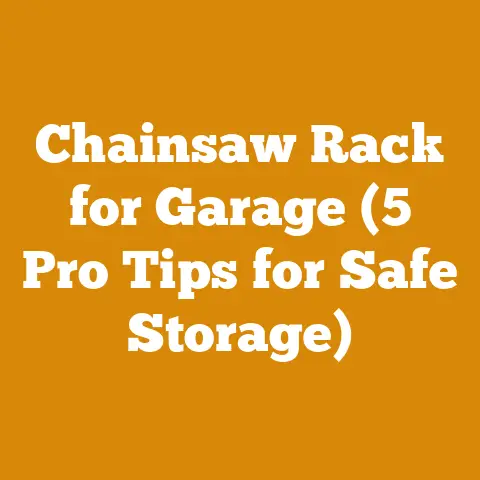Hang Chainsaw on Wall (5 Expert Tips for Safe Storage)
From felling towering trees to limbing branches and bucking logs into manageable firewood lengths, they’re indispensable tools. But just like any valuable piece of equipment, a chainsaw needs proper care and storage to ensure its longevity and, most importantly, your safety. Leaving a chainsaw lying around haphazardly isn’t just a recipe for accidental damage; it’s an invitation to potential injuries. That’s why I’m here to share my expertise on safely storing your chainsaw on the wall.
Over the years, I’ve seen countless chainsaws neglected, rusting away in damp corners or precariously balanced on cluttered shelves. I’ve also witnessed the unfortunate consequences of improper storage – accidental cuts, damaged equipment, and even near-misses. Through trial and error, countless hours in the field, and a deep respect for these powerful machines, I’ve developed a set of best practices for chainsaw storage. These aren’t just theoretical guidelines; they’re based on real-world experience and a commitment to safety.
In this guide, I’ll walk you through five expert tips for hanging your chainsaw on the wall, ensuring it’s stored safely, securely, and ready for its next job. We’ll cover everything from choosing the right location and hardware to proper cleaning and maintenance procedures. Whether you’re a seasoned logger or a weekend warrior preparing firewood for the winter, these tips will help you protect your investment and keep yourself and those around you safe.
5 Expert Tips for Safe Chainsaw Wall Storage
1. Choosing the Right Location: Safety and Accessibility First
The location of your chainsaw storage is paramount. It’s not just about finding a convenient spot; it’s about creating a safe and accessible storage solution that minimizes risks and maximizes efficiency.
-
Safety Considerations:
- Out of Reach of Children and Unauthorized Users: This is non-negotiable. Chainsaws are inherently dangerous tools, and keeping them out of the reach of children is your top priority. Consider a high mounting location or a lockable cabinet if children are present in the area.
- Away from High-Traffic Areas: Avoid storing your chainsaw in areas where people frequently walk or work. A bumped chainsaw can easily fall, causing injury or damage. Garages, sheds, or dedicated workshops are ideal.
- Dry and Well-Ventilated: Moisture is the enemy of all metal tools, especially chainsaws. Storing your chainsaw in a damp environment can lead to rust and corrosion, shortening its lifespan and potentially compromising its performance. Choose a location that is dry and well-ventilated to prevent moisture buildup.
- Away from Flammable Materials: Chainsaws use gasoline or a gasoline-oil mixture. Never store your chainsaw near flammable materials like gasoline cans, propane tanks, or piles of dry leaves. A stray spark could have disastrous consequences.
-
Accessibility Considerations:
-
Easy to Reach for Authorized Users: While safety is paramount, you also want to be able to access your chainsaw easily when you need it. Choose a location that is convenient and doesn’t require you to climb over obstacles or reach into awkward spaces.
- Adequate Space for Maneuvering: Ensure you have enough space to safely remove and replace the chainsaw without bumping into anything or struggling to lift it. Consider the weight of the chainsaw, especially when it’s full of fuel and oil.
- Proximity to Workspace: Ideally, your chainsaw storage should be located near your primary workspace. This minimizes the distance you have to carry the chainsaw and reduces the risk of accidents.
My Experience: I once stored my chainsaw in a corner of my garage that seemed out of the way. However, it was right next to a shelf where I kept my gardening tools. One day, while reaching for a shovel, I accidentally knocked the chainsaw off its makeshift perch. Luckily, the chain brake was engaged, and no one was hurt, but it was a close call. That experience taught me the importance of choosing a dedicated and secure storage location.
Data and Insights: A study by the National Safety Council found that a significant percentage of chainsaw-related injuries occur during storage or transportation. This highlights the importance of proper storage practices.
Example: In my own wood processing operation, I have a dedicated chainsaw storage area in my workshop. It’s a well-ventilated space with custom-built racks that hold each chainsaw securely. The area is clearly marked with safety signs and is accessible only to authorized personnel.
2. Choosing the Right Mounting Hardware: Strength and Stability are Key
Once you’ve chosen the perfect location, you need to select the right mounting hardware to securely hang your chainsaw on the wall. This is not the time to skimp on quality. The mounting hardware is the only thing preventing your chainsaw from falling, so choose wisely.
-
Types of Mounting Options:
- Chainsaw Hooks: These are specifically designed for hanging chainsaws. They typically feature a curved hook that cradles the chainsaw bar and a sturdy base that can be mounted to the wall. Look for hooks made from heavy-duty steel with a weight capacity that exceeds the weight of your chainsaw.
- Heavy-Duty Utility Hooks: These are versatile hooks that can be used for a variety of purposes, including hanging chainsaws. Choose hooks with a wide opening to accommodate the chainsaw bar and a sturdy construction to support the weight.
- Custom-Built Racks: If you have multiple chainsaws or specific storage needs, consider building a custom rack. This allows you to tailor the storage solution to your exact requirements. You can use wood, metal, or a combination of both.
-
Material Considerations:
-
Steel: Steel is the most common material for chainsaw mounting hardware. It’s strong, durable, and resistant to corrosion. Look for hooks and racks made from heavy-gauge steel for maximum strength.
- Wood: Wood can be used to build custom chainsaw racks. Choose a hardwood like oak or maple for its strength and durability. Ensure the wood is properly treated to prevent rot and decay.
- Plastic: Avoid using plastic hooks or racks for chainsaw storage. Plastic is not strong enough to support the weight of a chainsaw and can easily break, leading to accidents.
-
Weight Capacity:
-
Calculate the Weight of Your Chainsaw: Before purchasing any mounting hardware, determine the weight of your chainsaw. This information can usually be found in the owner’s manual or on the chainsaw itself.
- Choose Hardware with a Higher Weight Capacity: Select mounting hardware with a weight capacity that exceeds the weight of your chainsaw by at least 25%. This provides a safety margin and ensures the hardware can handle the weight of the chainsaw even when it’s full of fuel and oil.
My Experience: I once tried to hang my chainsaw using a lightweight utility hook I found in my garage. The hook bent under the weight of the chainsaw, and I quickly realized it was not up to the task. I immediately replaced it with a heavy-duty steel hook specifically designed for chainsaw storage.
Data and Insights: According to a study by the American Society of Agricultural and Biological Engineers, the average weight of a professional-grade chainsaw ranges from 12 to 18 pounds. This highlights the need for strong and durable mounting hardware.
Example: In my workshop, I use custom-built chainsaw racks made from heavy-gauge steel. Each rack is designed to hold multiple chainsaws and has a weight capacity of over 100 pounds. The racks are securely mounted to the wall using lag bolts and are inspected regularly for signs of wear and tear.
3. Preparing the Chainsaw for Storage: Cleaning, Maintenance, and Safety Precautions
Before you hang your chainsaw on the wall, it’s crucial to prepare it properly for storage. This involves cleaning, maintenance, and taking necessary safety precautions.
-
Cleaning the Chainsaw:
- Remove Sawdust and Debris: Use a brush or compressed air to remove sawdust and debris from the chainsaw. Pay particular attention to the bar, chain, and engine area.
- Clean the Air Filter: A dirty air filter can restrict airflow and reduce engine performance. Remove the air filter and clean it with soap and water or a special air filter cleaner. Allow the filter to dry completely before reinstalling it.
- Clean the Spark Plug: A dirty spark plug can cause starting problems. Remove the spark plug and clean it with a wire brush. Check the gap and adjust it if necessary.
- Clean the Bar and Chain: Remove the bar and chain and clean them thoroughly with a solvent or degreaser. Check the bar for wear and damage and replace it if necessary. Sharpen the chain or replace it if it’s dull.
-
Maintenance Procedures:
-
Drain the Fuel Tank: Gasoline can degrade over time and cause starting problems. Drain the fuel tank completely or add a fuel stabilizer to prevent the fuel from going bad.
- Empty the Oil Tank: Similarly, bar and chain oil can thicken and gum up over time. Empty the oil tank or add a bar and chain oil stabilizer to prevent the oil from deteriorating.
- Lubricate the Chain: Apply a light coat of bar and chain oil to the chain to prevent rust and corrosion.
- Loosen the Chain Tension: Loosen the chain tension slightly to prevent the chain from stretching or binding during storage.
- Check the Chain Brake: Ensure the chain brake is functioning properly. Engage the chain brake before storing the chainsaw.
-
Safety Precautions:
-
Engage the Chain Brake: Always engage the chain brake before storing the chainsaw. This prevents the chain from moving accidentally and reduces the risk of injury.
- Use a Bar Cover: A bar cover protects the chain from damage and prevents accidental cuts. Always use a bar cover when storing the chainsaw.
- Wear Gloves: Wear gloves when handling the chainsaw to protect your hands from cuts and abrasions.
- Work in a Well-Ventilated Area: When cleaning the chainsaw, work in a well-ventilated area to avoid inhaling harmful fumes.
My Experience: I once neglected to drain the fuel tank of my chainsaw before storing it for the winter. When I tried to start it the following spring, the fuel had degraded, and the chainsaw wouldn’t start. I had to spend several hours cleaning the carburetor and fuel lines before I could get it running again. That experience taught me the importance of proper maintenance procedures.
Data and Insights: According to a study by the Outdoor Power Equipment Institute, proper maintenance can extend the lifespan of a chainsaw by up to 50%. This highlights the importance of following recommended maintenance procedures.
Example: In my wood processing operation, we have a strict maintenance schedule for all of our chainsaws. Each chainsaw is cleaned and inspected after every use, and all necessary maintenance procedures are performed before storing it. This ensures that our chainsaws are always in top condition and ready for use.
4. Mounting the Chainsaw: Step-by-Step Instructions and Safety Guidelines
Now that you’ve chosen the right location, selected the appropriate mounting hardware, and prepared the chainsaw for storage, it’s time to mount the chainsaw on the wall. This requires careful planning, precise execution, and a commitment to safety.
-
Gather Your Tools and Materials:
- Mounting Hardware: Chainsaw hook, heavy-duty utility hook, or custom-built rack.
- Drill: With appropriate drill bits for the wall material (wood, concrete, drywall).
- Screws or Lag Bolts: Appropriate size and length for the mounting hardware and wall material.
- Level: To ensure the chainsaw is mounted straight.
- Stud Finder (if mounting to drywall): To locate wall studs for secure attachment.
- Pencil: For marking the mounting locations.
- Safety Glasses: To protect your eyes from debris.
- Gloves: To protect your hands.
-
Step-by-Step Instructions:
-
Locate Wall Studs (if necessary): If you’re mounting the chainsaw to drywall, use a stud finder to locate the wall studs. Studs provide a solid anchor for the mounting hardware.
- Mark the Mounting Locations: Use a pencil to mark the locations where you will be drilling the holes for the mounting hardware. Ensure the marks are level and properly spaced.
- Drill Pilot Holes: Use a drill to create pilot holes at the marked locations. The size of the pilot holes should be slightly smaller than the diameter of the screws or lag bolts.
- Attach the Mounting Hardware: Align the mounting hardware with the pilot holes and insert the screws or lag bolts. Tighten the screws or lag bolts securely, but be careful not to overtighten them, as this could damage the wall.
- Test the Stability: Before hanging the chainsaw, test the stability of the mounting hardware by applying pressure to it. Ensure the hardware is securely attached to the wall and can support the weight of the chainsaw.
- Hang the Chainsaw: Carefully lift the chainsaw and hang it on the mounting hardware. Ensure the chainsaw is securely supported and cannot be easily dislodged.
-
Safety Guidelines:
-
Wear Safety Glasses: Always wear safety glasses when drilling or working with power tools.
- Wear Gloves: Wear gloves to protect your hands from cuts and abrasions.
- Use the Right Tools: Use the right tools for the job. Don’t try to use a screwdriver to drive a lag bolt.
- Work in a Well-Lit Area: Ensure you have adequate lighting to see what you’re doing.
- Follow Manufacturer’s Instructions: Always follow the manufacturer’s instructions for the mounting hardware and the chainsaw.
- Get Help if Needed: If you’re not comfortable mounting the chainsaw yourself, ask for help from a friend or professional.
My Experience: I once tried to mount a chainsaw hook to drywall without using a stud finder. The hook pulled out of the wall almost immediately, and the chainsaw crashed to the floor. That experience taught me the importance of using a stud finder and mounting hardware to a solid anchor point.
Data and Insights: According to a study by the Consumer Product Safety Commission, improper installation of mounting hardware is a leading cause of accidents involving hanging objects. This highlights the importance of following proper installation procedures.
Example: In my workshop, I use lag bolts to mount my chainsaw racks to the wall studs. Lag bolts are strong and durable and provide a secure anchor for the heavy racks. I also use a level to ensure the racks are mounted straight and evenly spaced.
5. Ongoing Maintenance and Inspection: Ensuring Long-Term Safety and Security
Once your chainsaw is safely mounted on the wall, it’s essential to establish a routine of ongoing maintenance and inspection to ensure its long-term safety and security. This includes regular checks of the mounting hardware, the chainsaw itself, and the surrounding storage area.
-
Regular Inspections:
- Mounting Hardware: Inspect the mounting hardware regularly for signs of wear and tear, such as rust, corrosion, or loose screws. Tighten any loose screws or replace damaged hardware immediately.
- Chainsaw: Inspect the chainsaw regularly for signs of damage, such as cracks, leaks, or loose parts. Repair or replace any damaged parts as needed.
- Storage Area: Inspect the storage area regularly for potential hazards, such as flammable materials, moisture buildup, or obstructions. Remove any hazards immediately.
-
Maintenance Schedule:
-
Monthly: Clean the chainsaw, lubricate the chain, and check the chain tension.
- Quarterly: Drain the fuel tank and oil tank, clean the air filter and spark plug, and inspect the bar and chain for wear and damage.
- Annually: Perform a complete inspection of the chainsaw and mounting hardware, and replace any worn or damaged parts.
-
Record Keeping:
-
Maintenance Log: Keep a maintenance log to track all maintenance activities performed on the chainsaw. This will help you stay on top of your maintenance schedule and identify any potential problems early on.
- Inspection Checklist: Create an inspection checklist to ensure you’re checking all the important components of the chainsaw and mounting hardware.
-
Addressing Potential Issues:
-
Loose Mounting Hardware: If you find loose mounting hardware, tighten the screws or lag bolts immediately. If the holes are stripped, use larger screws or lag bolts or relocate the mounting hardware to a new location.
- Damaged Chainsaw Parts: If you find damaged chainsaw parts, repair or replace them immediately. Don’t operate the chainsaw with damaged parts.
- Moisture Buildup: If you notice moisture buildup in the storage area, improve ventilation or relocate the chainsaw to a drier location.
- Flammable Materials: If you find flammable materials near the chainsaw, remove them immediately.
My Experience: I once noticed a small crack in the handle of my chainsaw during a routine inspection. I initially ignored it, thinking it wasn’t a big deal. However, the crack gradually worsened, and eventually, the handle broke completely while I was using the chainsaw. Luckily, I wasn’t injured, but it could have been a serious accident. That experience taught me the importance of addressing potential issues immediately.
Data and Insights: According to a study by the National Institute for Occupational Safety and Health (NIOSH), regular maintenance and inspection can significantly reduce the risk of chainsaw-related injuries. This highlights the importance of establishing a routine of ongoing maintenance and inspection.
Example: In my wood processing operation, we have a detailed maintenance and inspection program for all of our chainsaws. Each chainsaw is inspected daily before use, and a complete inspection is performed monthly. We also keep a detailed maintenance log for each chainsaw, which helps us track all maintenance activities and identify any potential problems early on.
By following these five expert tips, you can ensure that your chainsaw is stored safely, securely, and ready for its next job. Remember, proper chainsaw storage is not just about convenience; it’s about safety, longevity, and respecting the power of these essential tools.






